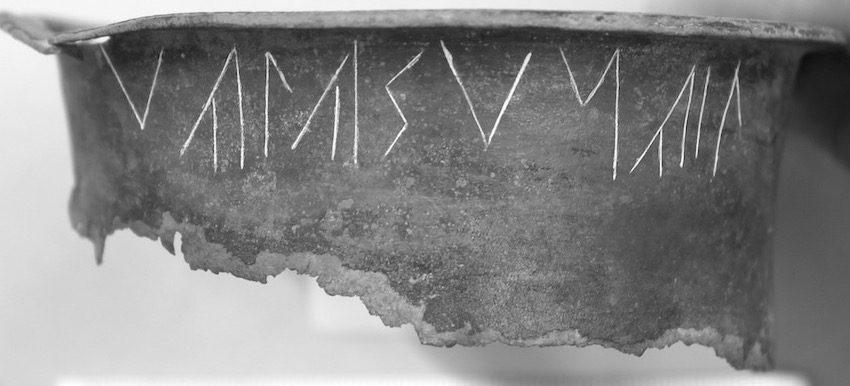Examples of writing
The Demlfeld plate (MLR 1)

Source: de Simone, Marchesini 2013.
The inscribed bronze plate from Demlfeld, near Ampass, was found during the archaeological digs conducted by the Innsbruck University (Tomedi et Alii 2006) in the sacred area Demlfeld (“Brandopferplatz”), and published extensively in a 2015 interdisciplinary miscellaneous volume (de Simone, Marchesini 2015). Human frequentation of the sacred area is attested during the second Iron Age (6th-1st century B.C.).
The plate, 10.4 x 7.8 cm, presents 5 lines written in a left-handed ductus. The first and second lines are badly preserved (full of blanks). The integrated text ?] s/t[2-3]ka.a[3-4] upiku tauke kleimunteis avaśuerasi IHI presents a dedication (upiku) made by Kleimunte (expressed in the ablative singular) to the Avaśuera (in the pertinentive/dative plural). The last part of the text (IHI) is probably an abbreviation or a chronological determination.
Inscription from Tesero, Sottopedonda, in Fiemme Valley, Trento (MLR 275)

Source: Marchesini 2012
The inscription from Tesero comes from a dwelling area, precisely from one room of a typical Rhaetic house, and it can be dated from the late Iron Age (between the 4th and the 3rd century B.C.). The text is written in four lines on a burned and polished bone and can be read as follows: kakaka[? taranip/l[? ?]aś/naφ/tṛas ṭarani[? a. The repetition of the name Tarani[, a local adaptation of a Celtic god name, and (for three times), of the deictic word ka, which can be compared with the Etruscan word set eta/eca/ta/ca, indicate a magic-religious text.
Miniature bronze shield from Cles, Mechel, Trento (MLR 37)

Source: MLR 37
The small bronze plate (10 x 7 cm) has a rectangular form with rounded angles and a central umbo, like a miniature shield. The inscription runs along the border with a right-to-left ductus: u{i}iku φeluriesi:φelvinuale. This is most probably a gift text (the first word should be read as upiku: the first iota is an error for pi), offered to a person represented by the praenomen Φelurie in the pertinentive case (-si), followed by a second name, Φelvinu, which is the father’s name (or patronymic) with the suffix -nu and pertinentive II -ale.
The text dates to Phase I of the Sanzeno epigraphic tradition, between the mid-5th to the end of the 3rd c. BCE.
Fragment of a bronze vase from Cles, Trento (MLR 27)

Source: MLR 27
Fragment of rim and handle of a bronze vase (diam. 10 cm). The inscription was sliced with a right-to-left ductus just under the rim: pianus apau. It is the “apau”, probably the object itself, of Pianu, expressed with the genitive -s. In this case it is not clear if the name Pianu is a -nu father’s name from a stem *Pia or, more probably, an -u name (*Pian-u).
The lack of characterising alphabetical types prevents the inscription from being placed within a determined chronological horizon. Not even the typology of the object, which is not intact, offers chronological clues. The dating must therefore be generically placed between the 6th and 1st centuries BC.
Fragment of olla from Stufles, Bressanone/Brixen (BZ) (MLR 16)

Source: Tecchiati et alii 2011. Gentile concessione di U. Tecchiati.
Fragment of the upper part of a blackish clay situliform olla, polished on the surface (h. preserved 16 cm), from the foundation pit of a house. The inscription is engraved with a regular and deep stroke on the neck of the olla and displays ]φ/rniχesi ta eluku a[, in which we recognise a pertinentive expressing the indirect object of the dedication (]φ/rniχesi), the deictic ta and the verbal noun eluku, the meaning of which remains obscure. The archaeological chronology points to a horizon of the mid-5th century B.C., confirmed by the epigraphic coordinates, which allow the text to be inserted into the epigraphic phase II of Sanzeno, dated from the mid-5th to the end of the 3rd century B.C.
Bronze rod from Cles, Campi Neri (TN) (MLR 30)

Source: MLR 30
Bronze cylindrical rod (11.4 cm long). A gold ring is knotted around the rod. The inscription is engraved with two texts facing and upside down relative to each other, starting at either end of the rod. The first text reads esumnesi, pertinentive (indirect object) of a personal name of Celtic etymology; the second text, nuᛏnuale upiku pianus again contains a verbal noun (upiku), affixing the subject, a genitive of a personal name (Pianus), possessor of the donated object, and a pertinentive II (in -ale) expressing the indirect object of the dedication, hence the recipient of the gift. The general sense of the text is thus (I) gift of Pianu as Esumne Nuᛏnu.